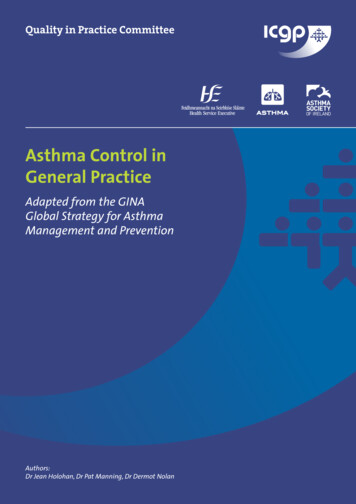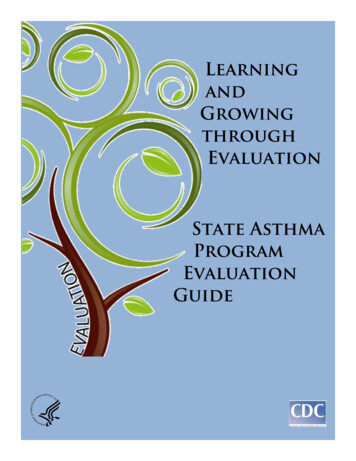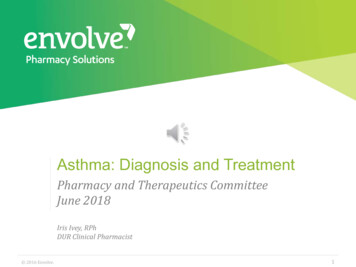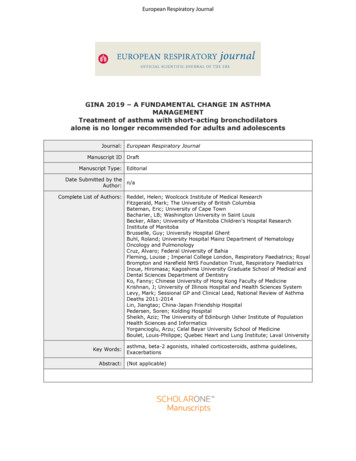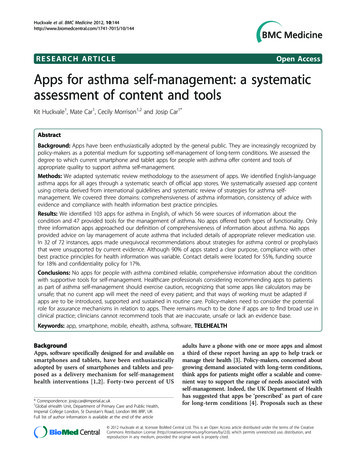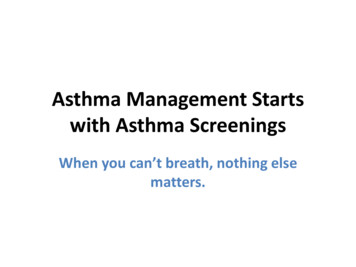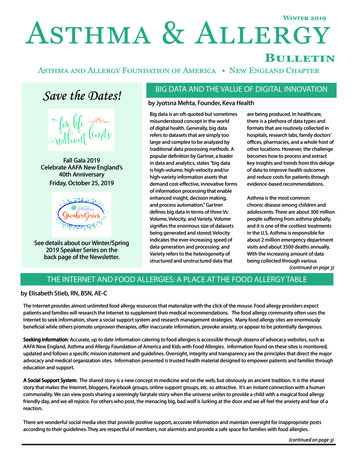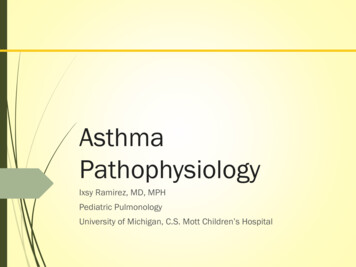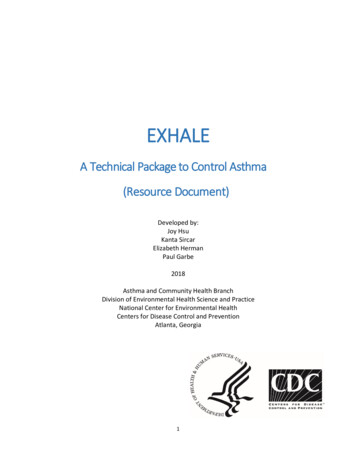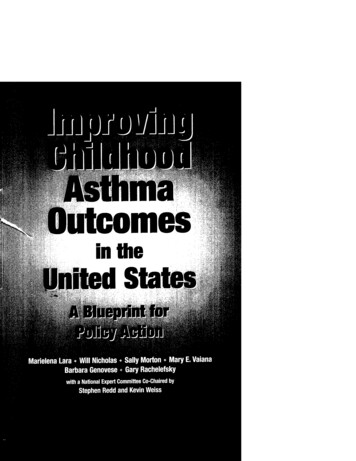
Transcription
mnmj iAsthmaOutcomesin HieUnited StetesMarielena Lara * Will Nicholas Sally Morton * Mary E. VaianaBarbara Genovese * Gary Rachelefskywith a National Expert Committee Co-Chaired byStephen Redd and Kevin Weiss
RAND Health UJCC'EO O 4 03 toQQfImprovingChildhoodAsthmaOutcomesin theUnited StatesA Blueprint forPolicy ActionMarielena Lara * Will Nicholas * Sally Morton Mary E. VaianaBarbara Genovese Gary Rachelefskywith a National Expert Committee Co-Chaired byStephen Redd and Kevin WeissSupported by the Robert Wood Johnson FoundationRANDrvj
The research described in this report was sponsored by the RobertWood Johnson Foundation.Library of Congress Cataloging-in-Publication DataImproving childhood asthma outcomes in the United States / Marielena Lara.[et. al.].p. cm."MR-1330."Includes bibliographical references.ISBN 0-8330-2997-51. Asthma in children—Government policy—United States. I. Lara, Marielena.RJ436.A8 1475 2001362.1 '9892238'00973—dc212001019562RAND is a nonprofit institution that helps improve policy anddecisionmaking through research and analysis. RAND is aregistered trademark. RAND's publications do not necessarily reflectthe opinions or policies of its research sponsors. Copyright 2001 RANDAll rights reserved. No part of this book may be reproduced in anyform by any electronic or mechanical means (includingphotocopying, recording, or information storage and retrieval)without permission in writing from RAND.Published 2001 by RAND1700 Main Street, P.O. Box 2138, Santa Monica, CA 90407-21381200 South Hayes Street, Arlington, VA 22202-5050201 North Craig Street, Suite 102, Pittsburgh, PA 15213-1516RAND URL: http://www.rand.org/To order RAND documents or to obtain additional information,contact Distribution Services: Telephone: (310) 451-7002;Fax: (310) 451-6915; Internet: order@rand.org(
PREFACEAn estimated 5 million U.S. children have asthma. Too many ofthese children are unnecessarily impaired. Much of the money spenton asthma is for high-cost health care services to treat acute periodsof illness. Many asthma attacks could be avoided—and muchsuffering prevented and many medical costs saved—if more childrenreceived good-quality, ongoing asthma care and if the 11 policyrecommendations presented in this report were implemented in acoordinated fashion.This report is dedicated to children with asthma and their caregivers.It summarizes the findings of an effort funded by the Robert WoodJohnson Foundation, to Identify a range of policy actions in both the public and privatesectors that could improve childhood asthma outcomes nationwide Select a subset of policies to create a blueprint for national policyin this area Outline alternatives to implement these policies that build onprior efforts.To conduct this work, RAND Health engaged an interdisciplinarypanel of nationally recognized leaders in childhood asthma in astructured group process to identify the policy recommendationsproposed in this report. This process, which included a face-to-faceexpert committee meeting, led to the development of a comprehensive policy framework that maps the identified strategies to one overall policy objective: to promote the development and maintenancePreceding Page*5 Blank
ivImproving Childhood Asthma Outcomes in the United Statesof asthma-friendly communities—communities in which childrenwith asthma are swiftly diagnosed, receive appropriate and ongoingtreatment, and are not exposed to environmental factors that exacerbate their condition.The 11 policy recommendations presented in this report are a national call to action. The recommendations span public and privateinterests and involve the integration of public health activities acrosslocal, state, and federal levels.The intent of the blueprint is to provide inspiration for innovativeways to strengthen the collaboration and communication amongnational and local community leaders and programs, and to successfully translate these national policies into local community practices.This effort is part of the Robert Wood Johnson Foundation's PediatricAsthma Initiative. The purpose of this initiative is to address currentgaps in national childhood asthma care through clinical and nonclinical approaches to improve the management of childhoodasthma. It is the first national initiative that simultaneously addresses treatment, policy, and financing issues for children withasthma at the patient, provider, and institutional levels.The report is based on research conducted under the auspices ofRAND Health. RAND Health furthers RAND's mission of helping improve policy and decisionmaking through research and analysis, byworking to improve health care systems and advance understandingof how the organization and financing of care affect costs, quality,and access.
NATIONAL EXPERT COMMITTEE MEMBERS ANDRAND HEALTH STAFFNATIONAL EXPERT COMMITTEE MEMBERSStephen ReddCommittee Co-ChairChief, Air Pollution andRespiratoryHealth BranchCenters for Disease Control andPreventionNoreen ClarkDean, Marshall H. BeckerProfessor of Public HealthUniversity of MichiganNicole Lurie(Formerly) Principal DeputyAssistant Secretary for HealthDepartment of Health andHuman ServicesThomas Platts-MillsDirector, Asthma and AllergicDiseases CenterUniversity of VirginiaKevin WeissCommittee Co-ChairDirector, Center for HealthcareStudiesNorthwestern Medical SchoolSara RosenbaumDirector, Center for HealthServices Research and PolicyThe George WashingtonUniversity School of PublicHealth and Health ServicesVernon SmithPrincipalHealth Management AssociatesLani WheelerPediatric and School HealthConsultantAnne Arundel CountyDepartment of HealthMaryland
viImproving Childhood Asthma Outcomes in the United StatesRAND HEALTH STAFFMarielena LaraPrincipal InvestigatorWill NicholasAssociate Policy AnalystGary RachelefskyCo-Principal InvestigatorAllergy Research FoundationMarian BranchEditorSally MortonHead, Statistics GroupMary E. VaianaCommunications DirectorBarbara GenoveseProject ManagerCarolyn Rogers andAlaida RodriguezAdministrative Assistants
LIST OF EXTERNAL REVIEWERSAgency for Healthcare Research and QualityDenise M. Dougherty, Ph.D.Senior Advisor, Child HealthAmerican Academy of Allergy, Asthma & ImmunologyGail G. Shapiro, M.D.President-ElectAmerican Academy of Family PhysiciansHerbert F. Young, M.D., MA.Director, Scientific Activities DivisionBarbara P. Yawn, M.D., M.Sc.Director of Research, Olmsted Medical CenterAmerican Academy of PediatricsRobert A. Wood, M.D.Section on Allergy and Immunology Executive CommitteeDepartment of Pediatrics, School of MedicineThe Johns Hopkins HospitalAmerican Academy of Physician AssistantsGabriel Ortiz, M.P.A.S., P.A.American Association of Health PlansPeter Fitzgerald, M.Sc.Director, Quality Management and Health Services Research
viii Improving Childhood Asthma Outcomes in the United StatesAmerican College of Allergy, Asthma & ImmunologyEmil J. Bardana, Jr., M.D.PresidentWilliam Storms, M.D.Asthma and Allergy Associates, Colorado Springs, COAmerican College of Emergency PhysiciansAmerican Lung AssociationFran DuMelleExecutive Vice PresidentAmerican Pharmaceutical FoundationWilliam M. Ellis, R.Ph., M.S.Executive DirectorAmerican Public Health AssociationLarry K. Olsen, Dr.P.H., CHESChair, School Health Education and Services SectionAmerican Public Human Services AssociationLee PartridgeDirector of the Health Policy UnitErin NagyHealth Policy AnalystAmerican Thoracic SocietyWilliam J. Martin, II, M.D.PresidentAsthma & Allergy Foundation of AmericaMaryWorstell, M.P.H.Executive DirectorAsthma and Allergy Network/Mothers of AsthmaticsNancy SanderPresidentEnvironmental Protection AgencyMary T. SmithDirector, Indoor Environments Division
List of External ReviewersHealth Care Financing AdministrationTimothy M. WestmorelandDirector, Center for Medicaid and State OperationsM. Beth Benedict, R.N., Dr.P.H., J.D.Social Science Research AnalystOffice of Strategic PlanningBeverly Koops, M.D.Medical Director, Health Care FinancingTexas Department of HealthHealth Resources and Services AdministrationPeter C. van Dyck, M.D., M.P.H.Associate AdministratorMaternal and Child Health BureauNational Committee for Quality AssuranceL. Gregory Pawlson, M.D., M.P.H.Executive Vice PresidentNational Heart, Lung, and Blood InstituteClaude Lenfant, M.D.Director and Chair of the National AsthmaEducation and Prevention CommitteeVirginia Taggart, M.P.H.Division of Lung DiseasesDiana SchmidtCoordinator, National Asthma Education and PreventionCommitteeRobinson Fulwood, Ph.D., M.S.P.H.Senior Manager, Office of Prevention, Education, and ControlNational Institute of Allergy and Infectious DiseasesAnthony S. Fauci, M.D.DirectorNational Institute of Child Health and Human DevelopmentDuane Alexander, M.D.Directorix
xImproving Childhood Asthma Outcomes in the United StatesNational Institute of Environmental Health SciencesKenneth Olden, Ph.D.DirectorPacific Business Group on HealthCheryl Damberg, Ph.D.Director of Research and QualitySociety for Academic Emergency MedicineBrian J. Zink, M.D.PresidentJill Baren, M.D., FAAPChair, Pediatric Interest GroupCarlos Camargo, M.D., Dr.P.H.Assistant Professor of MedicineHarvard Medical SchoolUniversity of California, Los Angeles; and RAND HealthArleen Leibowitz, Ph.D.Chair, Department of Policy StudiesU.S. Department of EducationDebra Price-EUingstad, Ed.D.Education Program SpecialistOffice of Special Education ProgramsU.S. Department of Housing and Urban DevelopmentWarren Friedman, Ph.D., CIH
CONTENTSPREFACENATIONAL EXPERT COMMITTEE MEMBERS AND RANDHEALTH STAFFLIST OF EXTERNAL REVIEWERSEXECUTIVE SUMMARYACKNOWLEDGMENTSABBREVIATIONSChapter OneINTRODUCTIONChapter TwoPOLICY CONTEXTThe Childhood Asthma EpidemicThe Costs of AsthmaA Public Health Problem with Multiple Causes,Requiring a Variety of ResponsesRisk FactorsPerformance Measures for Asthma CareEnvironmental FactorsEffects on SchoolsA Complex ProblemCurrent Asthma Efforts Need Increased Coordinationand FundingPublic-Sector EffortsPrivate-Sector EffortsI»vvüxvxxxixxxiii15566778889911
xiiImproving Childhood Asthma Outcomes in the United StatesChapter ThreeOVERVIEW OF METHODSChapter FourPOLICY FRAMEWORKPromotion of Asthma-Friendly CommunitiesNationwideComprehensive Policy Goals and ApproachesPolicy Goals Emerging from the Expert Panel Process .Policy Goal No. 1: Improve Access to and Quality ofAsthma Health Care ServicesPolicy Goal No. 2: Improve Asthma Awareness AmongAffected Individuals and the General PublicPolicy Goal No. 3: Ensure Asthma-Friendly Schools .Policy Goal No. 4: Promote Asthma-Safe HomeEnvironmentsPolicy Goal No. 5: Encourage Innovation in AsthmaPrevention and ManagementPolicy Goal No. 6: Reduce Socioeconomic Disparities inChildhood Asthma OutcomesChapter FivePOLICY RECOMMENDATIONSImproving Health Care Delivery and FinancingPromoting Quality of Care for Key Childhood AsthmaCare ServicesExpanding Coverage and Improving Benefits Design . .Map of Health Care Delivery and Financing PolicyRecommendationsStrengthening the Public Health InfrastructurePublicly Funding Asthma-Related Services That FallOutside the Health Insurance SystemIncreasing Public Awareness and Knowledge ofAsthmaImproving Surveillance and Prevention ResearchEffortsMap of Public Health Infrastructure 6434545535662
Contents xiiiChapter SixCONCLUSIONNext StepsImplications of the Children's Health Act of 2000656567Appendix: FEDERAL LEGISLATION RELEVANT TOCHILDHOOD ASTHMA69References79
Executive SummaryIMPROVING CHILDHOOD ASTHMA OUTCOMESIN THE UNITED STATES: A BLUEPRINTFOR POLICY ACTIONAlmost everyone knows a child with asthma. Althoughasthma is a treatable disease, too many children withasthma suffer unnecessarily. Some even die. Yet childrenwhose asthma is properly controlled can lead fully activelives, with minimal symptoms.The number of persons with asthma in the United Stateshas doubled in the past 15 years. Children are the mostaffected: An estimated 5 million children under 15 yearsold have this disease. The cases of asthma in children under 5 years old increased more than 160 percent between1980 and 1994. For children ages 5 to 14, the increase was74 percent. Asthma is more common among children whoare poor, African American, or Puerto Rican.The disease has serious economic consequences. Asthmacost an estimated 10.7 billion in 1994—more than half ofit for direct medical expenses, the rest for indirect costsassociated with school and work days lost, as well as withpremature mortality. A significant portion of the medicalexpenses was for tertiary care, such as hospitalizationsand emergency room visits.Medical care for asthma has improved significantly. Effective primary care can help children with asthma to leadfully functional lives and prevent costly hospitalizations.The costs andconsequencesof childhoodasthma
xviImproving Childhood Asthma Outcomes in the United StatesYet the human and financial costs of childhood asthmacontinue to grow.Why? One major reason is that we still do not knowenough about the causes of asthma and its progression.We know that a variety of risk factors, including a geneticpredisposition, environmental exposure, poverty, and inadequate heath care services, play a role in asthma—butwe do not know their precise effects or how they interactwith each other. Another major reason is that the complexity of this public health problem points toward solutions involving many different organizations and sectorsof U.S. society.Childhood asthma is a national public health problemthat challenges not only the entire health system but alsoschool systems and the many public and private organizations that track the effects of this illness, provide education and other community-based programs, and fund research into the causes of asthma. Improving care forchildhood asthma will require better coordination of ongoing national efforts, as well as a significant commitmentof national resources. Equally important is the commitment of individual state and local organizations and individual communities nationwide. Success will depend onintegrating local, state, and national efforts.Our purposeandapproachIn October 1999, the Robert Wood Johnson Foundationfunded RAND Health to outline future directions for childhood asthma policy in the United States. The purposesof this effort, conducted as part of a broader PediatricAsthma Initiative sponsored by the Foundation, were to Identify a range of policy actions in both the publicand private sectors that could improve childhoodasthma outcomes nationwide. Select a subset of policies to create a blueprint for national policy in this area. Outline alternatives to implement these policies thatbuild on prior efforts.
Executive Summary xviiRAND Health engaged an interdisciplinary panel ofnationally recognized leaders in childhood asthma, theNational Expert Committee, in a structured group process.The panel identified 11 policy recommendations that forma comprehensive framework for achieving one broad policy objective: to promote the development and maintenance of asthma-friendly communities.In an asthma-friendly community, children with asthmaare quickly diagnosed and receive appropriate and ongoing treatment; health care, school, and social agenciesare prepared to meet the needs of children with asthmaand their families; and children are safe from physical andsocial environmental risks that exacerbate tionwideThe RAND panel also identified six policy goals to meet its Policy goalsobjective of promoting asthma-friendly communities: Improve access to and quality of asthma health careservices. Improve asthma awareness among affected individuals and the general public. Ensure asthma-friendly schools. Promote asthma-safe home environments. Encourage innovation in asthma prevention andmanagement Reduce socioeconomic disparities in childhood asthma outcomes.The panel's policy recommendations for meeting these Translatinggoals span public and private interests and call for the goals intointegration of public health activities across local, state, 11 policyand federal levels. The 11 recommendations fall into two recommendationsbroad areas, and are described below:
xviiiImproving Childhood Asthma Outcomes in the United States Improving health care delivery and financingRecommendations in this area are designed to— Promote quality of care for key childhood asthmacare services (Recommendations 1,2, and 3).— Increase access to these services by expanding insurance coverage, improving benefits design, andeducating health care purchasers (Recommendations 4,5, and 6). Strengthening the public health infrastructureThese recommendations are directed at the governmentagencies responsible for administering and financingpublic health functions that support and supplement thehealth care delivery system. They are designed to— Publicly fund asthma-related community andhealth services that fall outside the health insurance system (Recommendations 7 and 8).— Increase public awareness and knowledge ofasthma (Recommendation 9).— Improve surveillance and prevention research efforts (Recommendations 10 and 11).RECOMMENDATIONS FOR IMPROVING HEALTHCARE DELIVERY AND FINANCING1. Develop and Although evidence-based guidelines are available forimplementchildhood asthma, there is a substantial gap between acprimarycare cepted best practices for asthma care and the care delivperformance ereci in the primary care setting. The Committee recommeasuresfor mends that health care regulators, insurers, and healthchildhoodcare delivery organizations implement the use of primaryasthma carecare performance measures for childhood asthma. To encourage adherence to guidelines health care organizationswould use provider-education strategies of proven effectiveness and offer financial incentives. In the absence ofuniversal access to primary care, special efforts to improve
Executive Summary xixcoordination between primary and emergency care arenecessary.Implementation Options. The National Asthma Education and Prevention Program (NAEPP) would play a keyrole in coordinating the dissemination of childhoodasthma care guidelines to insurers, managed care organizations, and state agencies for Medicaid and for the StateChildren's Health Insurance Program. Quality monitoringorganizations such as the National Committee for QualityAssurance (NCQA) would work with the NAEPP, professional organizations, and parent organizations to incorporate asthma-care performance measures into NCQA'sHEDIS (Health Plan Employer Data and Information Set)performance measurement system or into alternativequality measurement systems. These efforts could drawon previous successful models for guideline implementation and performance measurement for diabetes andcancer.Funding Options. Federal funding would supportNAEPP's expanded role in maintaining up-to-date guidelines. The NAEPP could also solicit funding from privatesources to supplement these activities, as was done for thepublication of the original guidelines. Funding for thedevelopment of performance measures could be soughtfrom the pharmaceutical industry, Health Care FinancingAdministration, and NCQA. Other funding for updatingand disseminating quality performance measures wouldcontinue to come from the health care and healthinsurance organizations that now perform these tasks.Educating patients about their disease can improve theirability to manage the disease and prevent complications that lead to hospitalizations and emergency department visits. The Committee recommends that theNational Asthma Education and Prevention Program(NAEPP) use its current recommendations for asthma selfmanagement education to develop and disseminate aspecific set of patient-education performance measures to2. Teach allchildren withpersistentasthma andtheirfamiliesa specificset ofself managementskills
xxImproving Childhood Asthma Outcomes in the United Statesbe used for quality monitoring; that education materialsmeet patients' language and literacy requirements; andthat health care purchasers and providers encourageasthma education for all children with persistent asthma.Implementation Options. The NAEPP, in collaborationwith appropriate professional organizations, would takethe lead in establishing performance measures for thecontent of asthma education and self-management programs and in disseminating these measures. The NationalCommittee for Quality Assurance and other quality monitoring organizations would work with the NAEPP to incorporate these measures into NCQA's HEDIS performancemeasurement system or into alternative quality monitoring systems. Professional and lay organizations would beinvolved in the development of educational materials forpatients and their families and would work closely withtheir local affiliates to implement asthma patient education at the local facility level.Funding Options. Efforts to establish performance measures would be funded by the federal government and private philanthropic organizations. Collaborative fundingfrom the pharmaceutical industry could also be sought.Funding for the provision of asthma self-management education to patients would be covered by public and private insurers as allowed by federal and state laws (seeRecommendations 5-6). For children without healthinsurance, these services would be covered through thepublic health infrastructure (see Recommendation 7).3. Providecasemanagementto high-riskchildrenAsthma case-management is a comprehensive set of services, provided by teams of medical professionals andsocial work staff, that includes intensive tracking, coordinated care, and follow-up. Case-management increasesthe effectiveness of patient education and reduces morbidity and use of emergency services among inner-citychildren with asthma. Because case-management services are expensive, it makes sense to focus them on highrisk children.
Executive Summary xxiThe Committee recommends that the National AsthmaEducation and Prevention Program (NAEPP) develop evidence-based performance measures for casemanagement, and that health care purchasers andproviders encourage their use among all high-risk childrenwith asthma.Implementation Options. The NAEPP and the Agencyfor Healthcare Research and Quality Asthma Evidencebased Practice Center would take the lead in synthesizingexisting research on asthma case-management. Professional organizations would disseminate these guidelinesto providers, targeting those in high-risk areas. The American Association of Health Plans and managed care organizations could encourage their health plans to providecase-management services. State Medicaid and StateChildren's Health Insurance Program programs couldensure that all contracting plans have the capacity to provide case-management services to high-risk areas. TheHealth Resources and Services Administration couldensure the same for federally funded community healthcenters.Funding Options. Funding for updating and disseminating quality performance measures for case-managementwould continue to come from the organizations that nowperform these tasks. The pharmaceutical industry couldalso provide collaborative funding. Case-managementservices would be funded through public and privatehealth insurers (see Recommendation 5) and the publichealth infrastructure (see Recommendation 7).All children need health insurance, and continuous insurance coverage is critical for improving the health of children with asthma. Existing insurance mechanisms can goa long way toward achieving the goal of insuring all children. In concert, the current Medicaid and State Children's Health Insurance Program (SCHIP) programs havethe potential to ensure that virtually all children haveaccess to health insurance coverage, regardless of family4. Extendcontinuoushealthinsurancecoverage to alluninsuredchildren
xxiiImproving Childhood Asthma Outcomes in the United Statesincome. But even with vigorous state efforts, two groupsof children would remain at risk of being uninsured: children of working parents who do not qualify for public insurance but do not have insurance from their employers,and children who are not citizens.The committee recommends that Congress extend continuous health insurance coverage to all uninsured children; that states make maximum use of Medicaid andSCHIP; and that federal and state policies create incentives for employers to offer affordable coverage to allworkers with children, and extend coverage to all childrenresiding in the United States, regardless of legal status.Implementation Options. Asthma-related organizationswould develop collaborations to educate state governments about the importance of improving Medicaid andSCHIP coverage, as well as the importance of new lawsthat encourage employers to furnish affordable coverage.They would also educate health insurance and smallbusiness organizations about the importance of providingaffordable coverage to workers. Potential beneficiarieswould be made aware of expanded eligibility and coverage.Funding Options. Federal and state governments wouldneed to appropriate additional funds to expand eligibilityand coverage for public insurance. Through direct appropriation or tax incentives, Congress could encourageemployers to offer family coverage at subsidized rates.Congress would also have to pass legislation to make noncitizen children who meet program requirements eligiblefor full coverage under Medicaid and SCHIP.5. Developmodel Children with asthma must have insurance benefit packages that reflect appropriate performance standards ofchildhood asthma care. But certain services essential forproper treatment of these children may not be routinelycovered by private health insurance plans and may not becovered under state SCHIP plans maintained separatelyfrom Medicaid.
Executive Summary xxiiiThe Committee recommends that the appropriate agencies of the Department of Health and Human Services(DHHS) design a model insurance-benefit package forchildren with asthma according to the performance measures outlined in Recommendations 1-3. This modelinsurance-benefit package would include a set of basicbenefits for all children with asthma and certain extendedbenefits for children with moderate and severe persistentasthma.Implementation Options. The National Asthma Education and Prevention Program would work with appropriate agencies in DHHS, such as the Centers for DiseaseControl and Prevention (CDC), the Health Care FinancingAdministration (HCFA), and the Health Resources andServices Administration (HRSA), to design the modelasthma-benefit package. Legal experts could translate thepackage into contractual language. Since covered servicesunder Medicaid are broadly defined and often subject tointerpretation, it is particularly important that HCFA makeexplicit those model asthma benefits that are currentlycovered by Medicaid. State Medicaid directors could thenmake sure that all contracting Medicaid providers coverthose services.Funding Options. Funding for the development ofasthma-specific contractual language for health care purchasers could come from a combination of public andprivate sources, including the CDC, HRSA, Medicaid, andhealth insurance associations. Asthma-related health insurance benefits would be funded through premium payments and Medicaid (see Recommendation 4). For uninsured children, these services would be funded throughthe public health infrastructure (see Recommendation 7).Health care purchasers can use their purchasing power toaffect health care delivery patterns. They have the opportunity, through the contracting process, to change benefitsor to incorporate performance measures or guarantees.The Committee recommends that, once model benefit6. Educatehealth carepurchasersabout asthmabenefits
xxiv Improving Childhood Asthma Outcomes in the United Statespackages for essential asthma services have been developed (see Recommendation 5), purchasers be trained inhow to evaluate and procure benefit packages that encourage the provision of quality asthma care that is basedon performance measures (see Recommendations 1-3).Implementation Options. Professional and private philanthropic organizations can facilitate training of healthcare purchasers. The National Association of State Medicaid Directors' Maternal and Child Health TechnicalAdvisory Group could be instrumental in educating andtraining state Medicaid program officers. Health-carepurchasing coalitions that have experience incorporatingquality guidelines into contractual agreements could alsoplay an important role.Funding Options. Philanthropic organizations could fundthe education process. Health insurance organizationsand employers could pay for the training and technicalassistance they receive, which will benefit them financiallyin the long run.RECOMMENDATIONS FOR IMPROVING THEPUBLIC HEALTH INFRASTRUCTURE7. Establishpublic healthgrants to fosterasthmafriendlycommunitiesand homeenvironmentsThe Children's Health Act of 2000 established asthma as aspecific focus within the Public Health Service Act andauthorized appropriation of funds to increase access totreatment and prevention in high-risk communities and toimprove asthma surveillance. If adequately funded, thelegislation could provide high-risk communities with resources to improve services and coordinate activities.The Committee recommends that Congress and the Department of Health and Human Services (DHHS) work together to ensure adequate funding and implementation ofthe Children's Health Act, to support essential childhoodasthma services (see Recommendations 1-3) to childrenwho fall outside the health insurance system and promote
Executive Summary xxvasthma-friendly communities by addressing key environmental risk f
national and local community leaders and programs, and to success- fully translate these national policies into local community practices. This effort is part of the Robert Wood Johnson Foundation's Pediatric Asthma Initiative. The purpose of this initiative is to address current gaps in national childhood asthma care through clinical and non-
